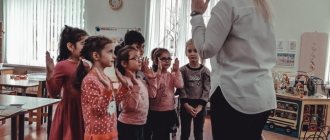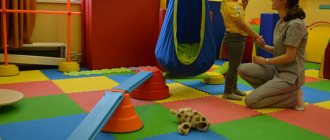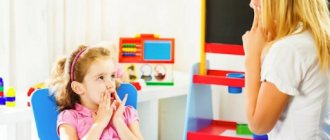Article:
A child masters speech through hearing, so it is very important to pay attention to the development of auditory perception . Games for the development of auditory perception contribute to the fact that the child begins to listen to surrounding sounds, the words of people close to him, his attention increases, and his memory improves.
Examples of games for the development of auditory perception .
Younger age:
- “Who’s screaming?” (An adult depicts the sounds of either baby domestic animals or their mothers, and the child guesses, names or shows the picture).
- “Kolobok” (the adult speaks for the hare, bear and fox in different voices, “Kolobok, Kolobok, I’ll eat you!”, and the child guesses).
-The same thing with the fairy tale “The Three Bears” - guess who says “Who was sitting on my chair?”
For middle and older children:
-Guess the sound of musical instruments (tambourine, pipe, drum, bell, rattle, harmonica).
-Guessing sounds when tapping a pencil on a metal box, glass jar, plastic glass, wooden box/table.
- Kinder cases with bulk products.
- “Who flies (swims, runs), a series of words are pronounced: falcon, milk, fish, mosquito... children clap their hands at the right moment.
- “Who came to us?”
A number of similar words are named, one of them is repeated many times, and children mark it with predetermined onomatopoeia. For example, the word nail among others: goose, bone, bush, bunch, growth, cane, throw; children's response is “knock-knock” or imitation of hammering nails.
- "Telephone".
The teacher calls a word or a simple tongue twister to the first child from each row; On command, those sitting in front turn back and pass on what was said to the next children.
The row in which the words reach the last child faster and without distortion receives a “challenge prize” - a flag, an asterisk...
children take part in the version of the game described below .
The teacher names four similar words, for example: point, barrel, daughter, hummock. Four guys take turns calling one word (dot, barrel, daughter, hummock, and the fifth says the first word of this series, etc. (There should be one less word than the number of players.) Whoever makes a mistake goes to the table to complete an individual task .
- “Name it, don’t yawn!”
Children receive two pictures, the names of which are similar in sound composition. The teacher pronounces the words, and the one who has the desired picture responds with a conditional phrase: “I have a poppy (varnish, onion, branch),” etc.
- “Find the mistake”
The bug didn’t finish the booth: it was reluctant, it was tired.
The snow is melting, the stream is flowing, the branches are full of doctors.
There are no roads in the swamp, I jump and jump over the cats.
2. Performing finger exercises has a positive effect on speech development (especially at a young age).
-Performing exercises and rhythmic movements with your fingers leads to stimulation in the speech centers of the brain, which stimulates speech development .
-Finger games teach you to listen and understand the meaning of speech , and increase the child’s speech activity.
— Finger gymnastics develops a child’s attention and memory, as he learns to remember certain hand positions and movements.
3. For correct sound pronunciation, it is necessary to perform articulatory gymnastics. Articulation gymnastics - exercises for training the organs of articulation (lips, tongue, lower jaw). Thanks to timely articulation gymnastics, some children themselves can learn to speak clearly and correctly, without the help of a specialist.
4. The development of speech is facilitated by breathing exercises, which are aimed at developing a long, smooth exhalation. Shallow breathing - there is enough air for one or two words (sometimes speech is interrupted even mid-sentence) can lead to stuttering. For this purpose , it is recommended to blow on toys floating in a basin, blow into a tube, the end of which is lowered into a glass of water, blow on a thread with something light hanging on the end, etc. Make sure to inhale through your nose without tension, do not stretch your shoulders. rise, exhale through the mouth, lips are pulled forward, cheeks do not puff out. Please note: to avoid dizziness caused by depletion of oxygen in the brain, the number of repetitions is no more than 4-5 times.
5. For the development of coherent speech, vocabulary work and improvement of grammatical structure are important. The names of objects, their parts, details are entered into the active dictionary; colors and their shades; shape, size and material from which they are made. The child learns to answer questions, naming both objects and their signs and actions. Children's vocabulary is replenished not only with nouns, but also with other parts of speech : adjectives, verbs, adverbs , numerals. When selecting material for classes, the age characteristics of the child are taken into account.
6. The child masters the grammatical forms of the language primarily in communication with others, in the process of enriching and activating the vocabulary, and the formation of coherent speech . Through didactic games and exercises, children's is drawn to those grammatical aspects, the acquisition of which causes them certain difficulties. These include errors in changing nouns by case: no boots, pencils instead of boots, pencils; there are no calves, goslings instead of calves, goslings. Gross mistakes were noted during approval: my dress, two little foxes, on a green tree and much more. Mastery of all these grammatical forms begins as early as three years of age.
Conclusion: correct pronunciation of sounds, along with a rich vocabulary and grammatically correct, well- developed coherent speech, is one of the indicators of a child’s readiness for schooling.
Reasons for the development of type 3 OHP
There are 2 groups of factors that can provoke general underdevelopment of level III speech. These include biological and social.
Biological factors can have an impact on the baby at different periods of its development - from prenatal to 3-4 years. These include moderate lesions of the central nervous system, as a result of which auditory perception and speech motor skills are impaired. Such damage to the central nervous system can be caused by a woman’s bad habits during pregnancy, severe toxicosis, traumatic birth, encephalopathy in a newborn, and traumatic brain injuries. Such children may suffer from dysarthria, aphasia, stuttering, alalia, rhinolalia (if there is a cleft palate).
Social factors are, first of all, the baby’s immediate environment. If there is an unfavorable atmosphere in the family, frequent conflicts, parents do not pay attention to the child or, on the contrary, are too demanding or anxious, do not talk to the baby or lisp (they speak “childishly”, in diminutive forms) - all this makes it difficult to master speech skills. Another provoking factor is bilingualism in the family. Bilingual children are often diagnosed with grade 3 ODD.
Classification of OHP into levels
There are 4 levels. Each group is characterized by a certain degree of severity of speech underdevelopment. This classification is of great importance when diagnosing young patients and subsequently enrolling them in speech therapy groups. After all, the correction program is selected taking into account the severity of speech disorders.
General speech underdevelopment grades 1 and 2 are assessed as severe disorders, while OSD III is considered a moderate deviation from the norm. However, it also requires the intervention of a speech therapist, since the level of development of linguistic means does not meet the age norm.
Characteristics of type 3 onr
The disorder is diagnosed in preschoolers aged 4–5 years. The main difference between this degree of impairment and others is that complex grammatical and lexical components are not sufficiently formed.
The main characteristic of type 3 OHP is a kind of initial stage of mastering the morphological system of language, when the baby already speaks in phrases, but with errors.
Here are the features of OHP level 3:
- the preschooler has phrasal, expressive speech, but it leaves much to be desired;
- the pronunciation of some sounds is incorrect and unclear;
- phonemic processes do not correspond to age norms;
- The vocabulary is large, it is enough to construct detailed phrases.
Preschoolers willingly communicate, conduct dialogue, and give detailed answers to questions.
Characteristics of a child with stage 3 ODD
Despite the higher level of speech skills, in contrast to OHP types 1 and 2, it is still difficult for strangers to understand what children are saying. Therefore, they usually communicate in the presence of close people - they act as translators.
Kids pronounce isolated sounds well, but they make mistakes in words: they speak unclearly, and replace complex sounds with easier ones. Especially difficult for them are hissing sounds, affricates (“ch”, “ts”), whistling and sonorant sounds (voiced unpaired consonants). If it is easy for a child to pronounce a certain sound, he can replace several more complex ones with it at once, for example: a soft “s” sound can replace both a hard “s” (“syanki” instead of “sankee”) and hissing ones (“syuba” instead of “ fur coat").
Preschool children with grade III SEN have a good active vocabulary, which is constantly updated with new words. However, words that are rarely used in everyday life are unknown to them. They operate with words of everyday meaning that are constantly in their ears.
The grammatical agreement of words in sentences has not yet been formed, but children with grade 3 OHP are already on the threshold of mastering complex constructions. For example, they can say: “Mama pislya i pyinesya Mase padaik, like Masya haasho sya vey,” that is, “Mom came and brought Masha a gift, since Masha behaved well.”
Although preschool children with level 3 ODD do not always speak correctly, they can already compose a simple story. Of course, this will be a description of a sequence of actions, but this is already formed phrasal speech.
The children are also making progress in coordinating words among themselves. Although they make mistakes, they do not always make them. Things are more complicated with the coordination of nouns and numerals. For example, instead of “three cats” the baby will say “three cats”, and instead of “many sparrows” - “many sparrows”.
Among the characteristics of children with level 3 ODD we also include incorrect pronunciation of difficult words. They swap syllables or skip them altogether. They also have difficulty analyzing words - they cannot name words that begin with a certain letter.
The listed problem areas need to be corrected, since they impede successful learning at school, primarily the acquisition of writing and reading skills.





